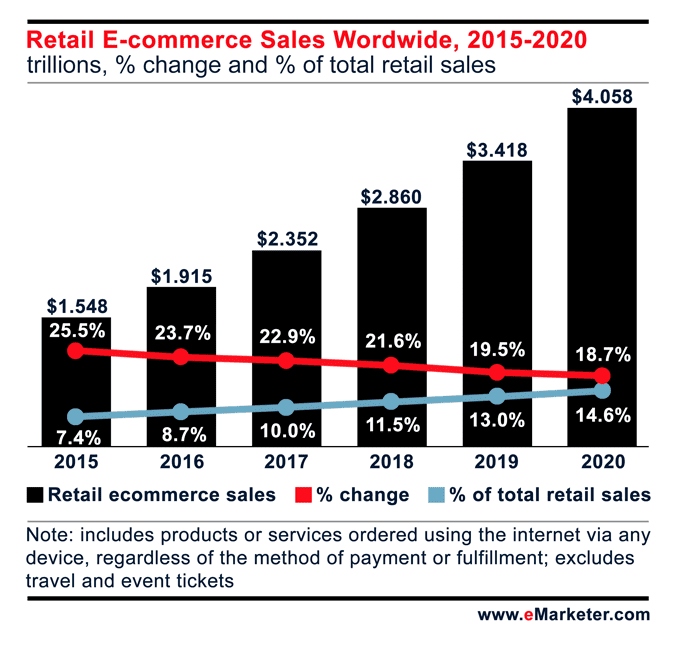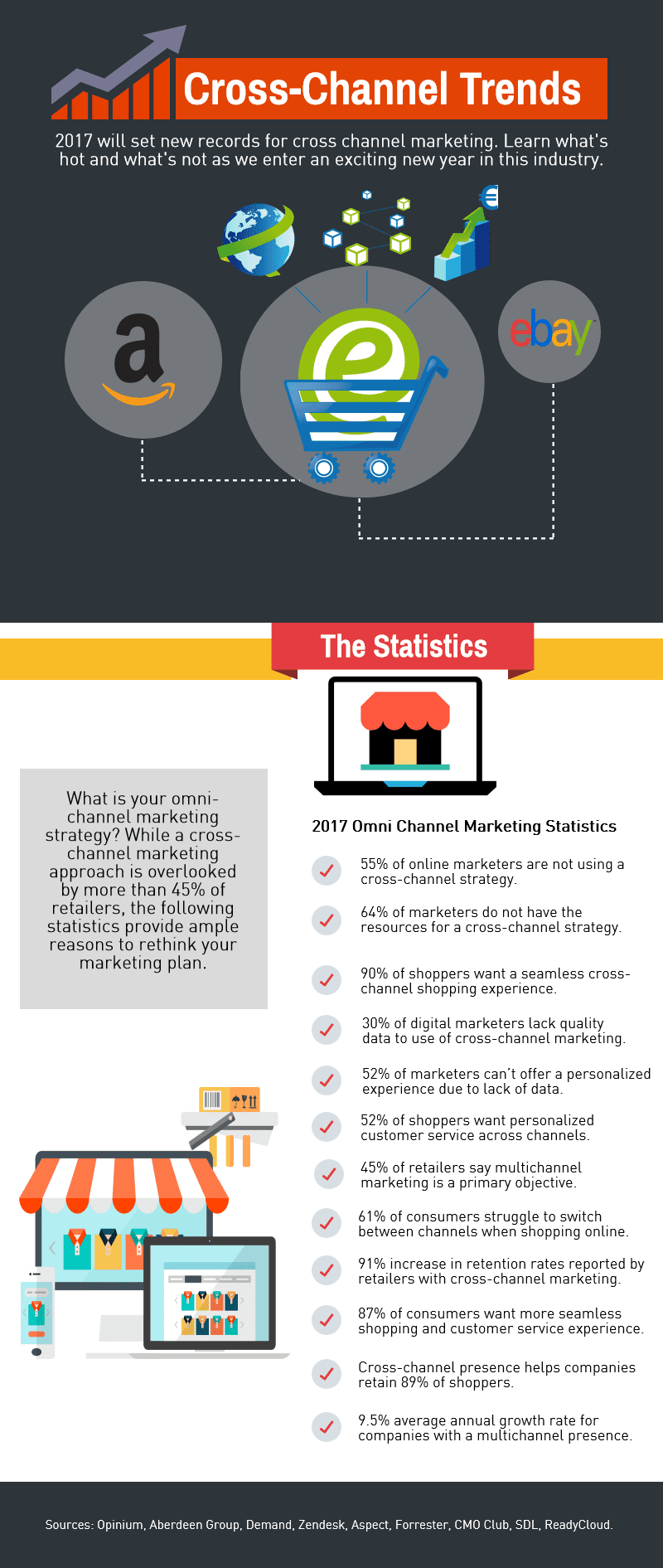A Look Ahead: 2017 Cross-Channel Selling Statistics You Need to Know

It’s a cross-channel ecommerce world. If you are not positioning your products in as many places as you can online, you’ll ultimately be undone by your competitor. Many online retailers host a presence on their website and in omni-channels like Amazon and eBay, as well as other channels like Newegg, Alibaba, Jet, Etsy, social media sites and various other marketplaces. They do this to attract as many sales as possible by creating as large of an online presence as they can.
Today’s online retail industry is growing faster than ever before. The most recent ecommerce statistics predict more than $2 trillion in sales for this year, with forward-thinking estimates forecasting 18.7% growth by 2020. Crunch the numbers, and ecommerce could be hauling in more than $4 trillion annually in just three short years.
 Indeed, it’s an exciting time to be involved in this industry. As multichannel selling avenues gain dominance, it’s always helpful to know what statistics are driving the true numbers. Stay in the know with our in-depth look at 2017 cross-channel selling statistics, and find out what’s breaking ground, what’s tried and true, and what’s out with the old.
Indeed, it’s an exciting time to be involved in this industry. As multichannel selling avenues gain dominance, it’s always helpful to know what statistics are driving the true numbers. Stay in the know with our in-depth look at 2017 cross-channel selling statistics, and find out what’s breaking ground, what’s tried and true, and what’s out with the old.
4 Eye-Opening Cross-Channel Marketing Statistics
Cross-channel selling enables retailers to attract and capture sales in an expanding multichannel ecommerce universe. These following multichannel ecommerce statistics helps us understand the importance of multifarious online presence.
- According to Wharton, about 66% of online shoppers rely on more than one channel for purchases. About one-third of consumers will rotate between these channels for various purchases. Around one-third of consumers will use two, three or more channels to make purchases.
- It takes almost 10 visits to the same retailer’s website for a shopper to convert into a customer. According to an Econsultancy study, the average consumer visited a retailer’s website 9.5 times before they converted. In between these visits, shoppers are assuredly webrooming (comparing prices at other online store and channels) to get the best deal, lowest shipping price and most lenient return policy.
- Omni-channel shoppers are more valuable overall. According to a Google report, shoppers who cross-channel shop are worth 30% more value in a lifetime to merchants than single channel shoppers.
- The majority of retailers are not engaging a cross-channel presence adequately. An Econsultancy report finds that just 5% of marketers are equipped to market across channels. Meanwhile, just 39% of retailers are able to digest the analytics necessary to create an effective cross-channel customer journey.
Omni-Channel Growth
Omni-channels are growing, fed by the consumer demand for competitive prices, cheap shipping and easy returns. These three integers aptly explain the popularity of giants like Amazon – which also gives shoppers a one-stop destination for just about everything, ranging from consumer goods to home services, groceries and more. Unsurprisingly, Amazon dominates online retailing, owning 26% of the market share.
But omni-channel growth is also supported by online retailers of all sizes and brick and mortar retailers with an online presence. As HBR reports, brick and mortar retailers that sustain an online presence are experiencing online growth in a declining brick and mortar world by as much as 9% once they incorporate omni-channel strategies.
“Traditional retailers have staked their futures on omnichannel retailing. The omnichannel strategy hinges on the idea that providing a seamless shopping experience in brick-and-mortar stores and through a variety of digital channels not only differentiates retailers from their peers, but also gives them a competitive edge over online-only retailers by leveraging their store assets,” explains HBR.
Think tank Strategy& has assessed the omni-channel growth rate for ecommerce, finding that the Compound Annual Growth Rate (CAGR) is a healthy 20%. The primary reason is because omni-channel shopping caters to the consumer, allowing them to choose their preferred medium and or shopping setting. With predictions showing a sharp increase of online sales by as much as 9.5% between now and 2018, you can bet that cross-channel ecommerce plays a strong role.
Must-Know Omni Channel Marketing Statistics
What is your omni-channel marketing strategy? While a cross-channel marketing approach is overlooked by more than 45% of retailers, the following statistics provide ample reasons to rethink your marketing plan.
- 55% of online marketers are not using a cross-channel strategy (CMO Club).
- 64% of marketers do not have the necessary resources to pursue a cross-channel strategy (CMO Club).
- 90% of shoppers want a seamless cross-channel shopping experience (SDL).
- 30% of digital marketers lack quality data to make use of cross-channel marketing (Dun & Bradstreet).
- 52% of marketers can’t offer a personalized marketing experience due to lack of proper data (Demand Metric).
- 52% of shoppers want personalized customer service across channels (Opinium Research).
- 45% of retailers say multichannel marketing is a primary marketing objective (Forrester).
- 61% of consumers struggle to switch between channels when shopping online (Aspect).
- Consumers use between four and six touchpoints when shopping online (Marketing Week).
- 91% increase in retention rates reported by retailers with cross-channel marketing plans in place (Aspect).
- 87% of consumers want a more seamless shopping and customer service experience (Zendesk).
- Cross-channel presence helps companies retain 89% of shoppers, as compared to just 33% without (Aberdeen Group).
- 9.5% average annual growth rate for companies that pursue a multichannel presence (Aberdeen Group).
Summary of 2017 Cross-Channel Marketing Trends
We leave you with this illustrated infographic. Feel free to share it on your own website to help spread the word. It provides a detailed look at the most important 2017 omni channel statistics, so you can make a well informed decision about your advertising budget.
Share On:









